 |
||||||||||||
|
September/October 2014 SCULPTING SORROW: Andrew Chernak & the Gold Star Mothers Monument
BY XANDE ANDERER
But by the late 1990s Chernak had turned his attention entirely to large-scale, fine art bronzes. Working in the classical vein of sculptors such as Bernini and Rodin, Chernak employs the traditional “lost wax” method used since ancient times. A detailed miniature clay maquette is created first for reference before then being scaled to a full-sized clay version. A rigid mold is then made to create a wax copy. Over this, a sand mold is made and the molten bronze poured inside. The real hallmarks of Chernak’s work are his high level of detail and historical accuracy. He takes particular pride in the countless hours he spends researching his subject matter. “I’m always searching for that marriage between art and reality of the sculpture,” Chernak said.
It is this reputation for historical accuracy that led to a flurry of commissions, including a larger-than-life bronze for the U.S. Army Engineers Memorial at Fort Leonard Wood, Missouri; “Freedom’s Sacrifice,” a veterans memorial in Dixon, Illinois; a bronze for the U.S. Army Medical School at Ft. Sam Houston, Texas; a statue of Medal of Honor recipient Bruce W. Carter at the Miami VA Medical Center; and the Battlefield Cross/Fallen Soldier Memorial in Coaldale, Pennsylvania.
Chernak’s subsequent proposal featured a life-sized statue of a grief-stricken mother steadying herself with one hand on a small table beside her. In her hand is the dreaded Western Union telegram she’d read with disbelief just moments before. Atop the table sits a photo of her son beside an overturned flower pot. Then-American Gold Star Mothers president Dorothy Oxendine approved the design, citing, in particular, “the dignity and strength that co-exist with her grief and sorrow.”
The statue was dedicated in July of 2006—the first such monument depicting a Gold Star Mother to be erected. The powerful reactions to the monument over the next few years sparked discussions about erecting copies of the statue in other locations. This prompted the AGSM president at the time, Judith Young, to remark that there should be a national monument honoring Gold Star Mothers. Discussions began to lobby for a Gold Star Mothers National Monument in Washington, D.C., with the Kent statue serving as a prototype for a slightly re-imagined monument.
A fresh survey of the approved site at Arlington National Cemetery, costing $12,000, has been completed, and final considerations such as traffic and visual sightlines are falling into place. Though other challenges still exist, the last big hurdle remains fund-raising, which has only now begun in earnest. Chernak is optimistic that groundbreaking can begin in about two years. In the meantime, Chernak is busy working on sculptures for other large-scale projects, including a memorial in honor of U.S.S. Indianapolis Chaplain Thomas Conway to be erected in his home town of Waterbury, Connecticut, and two bronze figures for a War on Terrorism memorial under construction in New England.
|
||||||||||||
|
|
||||||||||||
|
|
||||||||||||
8719 Colesville Road, Suite 100, Silver Spring. MD 20910 | www.vva.org | contact us |
||||||||||||








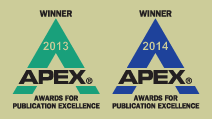
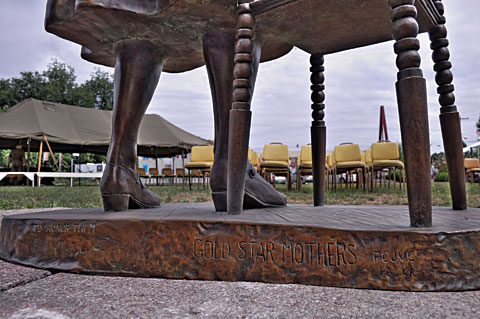
 You may not recognize the name of sculptor Andrew Chernak. But you may have stood before his work in quiet contemplation. His work may sit on your mantle, in your china cabinet, or appear as a prop in the movie you’re watching. His work may have greeted you as you approached the last museum you visited. That’s because Andrew Chernak has been practicing his trade prolifically since shortly after his return from Vietnam in 1970.
You may not recognize the name of sculptor Andrew Chernak. But you may have stood before his work in quiet contemplation. His work may sit on your mantle, in your china cabinet, or appear as a prop in the movie you’re watching. His work may have greeted you as you approached the last museum you visited. That’s because Andrew Chernak has been practicing his trade prolifically since shortly after his return from Vietnam in 1970.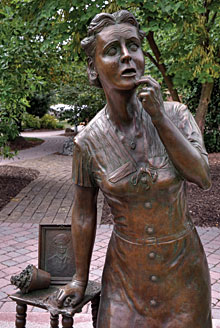 Chernak—an at-large VVA member—worked as a commercial sculptor throughout the 1970s and 80s, creating collectible art and figurines for companies such as the Franklin Mint, as well his own figurine company, Grenadier Models. By the late 1980s he was busy sculpting figures for museum dioramas all over the country—most notably the West Point Museum and the National D-Day Museum in New Orleans. His detailed copies of pewter buttons and other historical objects appeared in such big-budget films as The Patriot and The Last of the Mohicans.
Chernak—an at-large VVA member—worked as a commercial sculptor throughout the 1970s and 80s, creating collectible art and figurines for companies such as the Franklin Mint, as well his own figurine company, Grenadier Models. By the late 1980s he was busy sculpting figures for museum dioramas all over the country—most notably the West Point Museum and the National D-Day Museum in New Orleans. His detailed copies of pewter buttons and other historical objects appeared in such big-budget films as The Patriot and The Last of the Mohicans.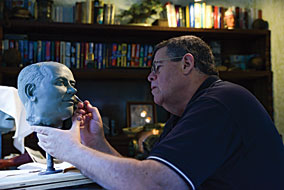 Having enlisted in the Army in 1968, Chernak went to Vietnam as a PFC and came home a sergeant. He served as a squad leader with Company C, 4th/12 Infantry of the 199th Light Infantry Brigade in and around Long An Province from 1969-70, receiving a Bronze Star and two Purple Hearts. Chernak feels his military experience is what gave him the sensitivity to achieve detail and authenticity in his work. Having lived history, he reasons, has empowered him to give his work a realism “that cannot be obtained by those who haven’t.”
Having enlisted in the Army in 1968, Chernak went to Vietnam as a PFC and came home a sergeant. He served as a squad leader with Company C, 4th/12 Infantry of the 199th Light Infantry Brigade in and around Long An Province from 1969-70, receiving a Bronze Star and two Purple Hearts. Chernak feels his military experience is what gave him the sensitivity to achieve detail and authenticity in his work. Having lived history, he reasons, has empowered him to give his work a realism “that cannot be obtained by those who haven’t.”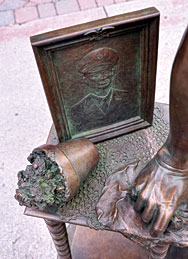 When infighting and political obstacles bogged down a 2002 plan to erect a simple stone plaque honoring Gold Star Mothers in Upstate New York, Putnam County Joint Veterans Council President Peter Allegretta sought to move the monument to Putnam County Veterans Memorial Park in nearby Kent, New York. He enlisted help from Army veteran Fred Waterman—who served with Chernak in Vietnam—and, over the course of the ensuing discussions, decided that the mothers deserved much more than a simple stone and plaque. He envisioned instead a classic bronze statue honoring “the moms” and recommended the council ask Chernak to sculpt it.
When infighting and political obstacles bogged down a 2002 plan to erect a simple stone plaque honoring Gold Star Mothers in Upstate New York, Putnam County Joint Veterans Council President Peter Allegretta sought to move the monument to Putnam County Veterans Memorial Park in nearby Kent, New York. He enlisted help from Army veteran Fred Waterman—who served with Chernak in Vietnam—and, over the course of the ensuing discussions, decided that the mothers deserved much more than a simple stone and plaque. He envisioned instead a classic bronze statue honoring “the moms” and recommended the council ask Chernak to sculpt it.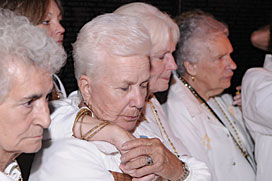 “The hardest part of the project was to have a face showing extreme grief and pain,” Chernak said. He chose as his model his wife, Terria, who knew such heartbreak, having suffered the loss of a daughter in a house fire six years earlier.
“The hardest part of the project was to have a face showing extreme grief and pain,” Chernak said. He chose as his model his wife, Terria, who knew such heartbreak, having suffered the loss of a daughter in a house fire six years earlier.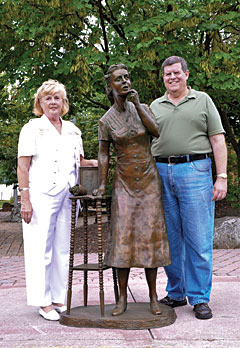 A 501©(3) foundation was formed to raise funds. Legislation was introduced in Congress seeking authorization to begin the planning process with the National Park Service. HR 1980, The Gold Star Mothers National Monument Act, passed in 2011, authorizing the foundation “to establish a monument in the District of Columbia area, to be maintained as a unit of the National Park System.” Plans for the monument have now moved past the notoriously contentious site selection process, having secured approval from the National Capital Memorial Advisory Commission, with the guidance of architect/consultant J.C. Cummings and Glen DeMarr, NPS Project Manager of Lands, Resources and. Planning for the National Capital Region.
A 501©(3) foundation was formed to raise funds. Legislation was introduced in Congress seeking authorization to begin the planning process with the National Park Service. HR 1980, The Gold Star Mothers National Monument Act, passed in 2011, authorizing the foundation “to establish a monument in the District of Columbia area, to be maintained as a unit of the National Park System.” Plans for the monument have now moved past the notoriously contentious site selection process, having secured approval from the National Capital Memorial Advisory Commission, with the guidance of architect/consultant J.C. Cummings and Glen DeMarr, NPS Project Manager of Lands, Resources and. Planning for the National Capital Region.